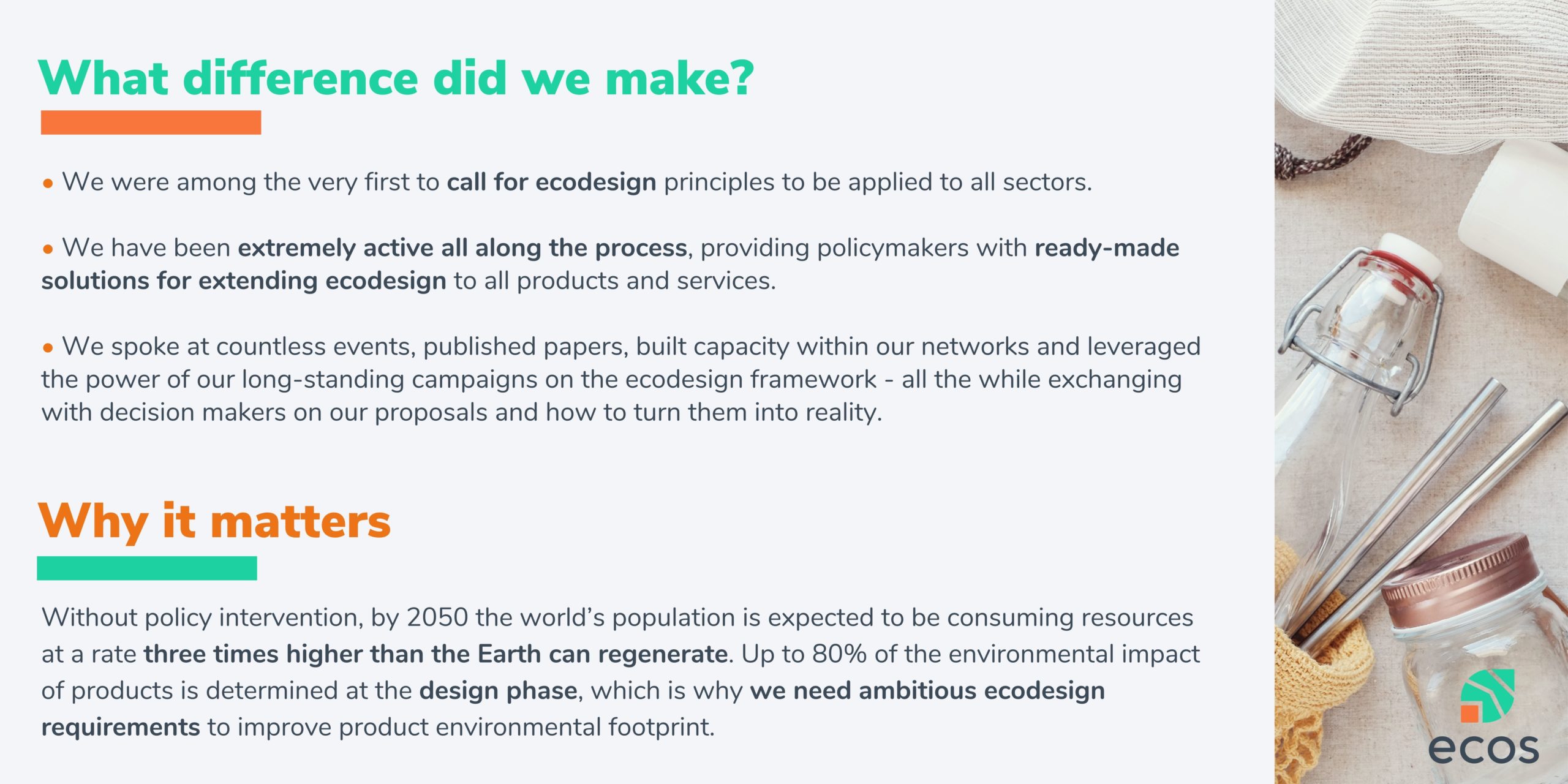Making sustainable products the norm – ecodesign as a tool for change
We have long known that we need to make sustainable products the norm. Without policy intervention, by 2050 the world’s population is expected to be consuming resources at a rate three times higher than the Earth can regenerate. In 2022, and following many years of advocacy from ECOS, the EU finally launched an initiative which could make this happen – with important repercussions for all products worldwide!

Designing for circularity
Up to 80% of the environmental impact of products is determined at the design phase, yet the linear pattern of ‘take-make-use-dispose’ does not fit with a circular economy model that helps respect planetary boundaries. Many products break too quickly, cannot be easily reused, repaired or recycled, or, worse still, are made for a single use only.
We have long campaigned for the ecodesign principles to apply to more products, such as plastics, textiles or furniture. Our efforts go years back: the ECOS annual events in 2019 and 2020 showed innovative ways of how ecodesign could be useful in making plastic less polluting and reducing the impacts of construction products, while in 2021 and 2022 we focused directly on making sustainable products the norm, both in the EU and worldwide.
We kept repeating it, until we were heard: To achieve a truly circular and non-toxic economy, we need to make sure that all the worst performing products – not only in terms of energy – are excluded from the market, by designing out their harmful environmental impacts.
Ecodesign will drive the change
In March 2022, it finally happened. The European Commission presented an ambitious package of regulatory proposals to implement its Circular Economy Action Plan. The proposal for a Regulation on Ecodesign for Sustainable Products (ESPR) extends ecodesign to a broad range of sectors, including textiles, furniture, ICT and intermediary products such as steel and cement, finally addressing negative environmental impacts embedded in products by design.
The ESPR is set to be a game-changer. In addition to circular economy measures that focus on material recovery – such as returning products to the supply chain instead of landfill – the ESPR also aims at building-in sustainability throughout the entire value chain. It seeks to unlock the potential of circular business models and more sustainable consumption, and addresses social aspects, too.
Since its first adoption in 2005, the Ecodesign Directive has allowed to transform the way energy-related products, including common appliances such as screens and washing machines, are designed. Extending the Directive to new sectors requires a major rethinking of this legal instrument, but has an enormous potential in terms of environmental benefits.
Ensuring ambition from beginning to end
We have been extremely active all along the process, not only advocating for extending ecodesign to all products and services on the EU market, but also relentlessly calling for an ambitious tool, one that will make a real difference. We spoke at countless events, published a series of position papers and factsheets (see resources here), built capacity within our networks and leveraged the power of our long-standing campaigns on the ecodesign framework – all the while exchanging with decision makers on our proposals and how to turn them into reality.
For ESPR to be truly successful, it needs to address sustainability hotspots throughout the product value chain, but also, importantly, it must roll out measures to reduce the EU’s material footprint as such.
Today, the proposed regulation includes an extensive scope of sectors. It also foresees a role for design requirements to eliminate substances of concern. This is an important complementary step to all chemicals legislation, aimed to enable toxic-free design of products. Finally, ESPR opens the door to banning the controversial and devastatingly polluting practice of destroying unsold goods.
In line with our calls, in 2022 the European Parliament put forward promising positions, in many cases increasing the proposal’s ambition. The EP ENVI Committee, leading on the file, proposed to tackle under ESPR practices such as planned obsolescence and industry self-regulation, or some of the thus far ‘overlooked’ product groups, including cement. The IMCO draft report, in turn, extended the ESPR scope to digital services, and introduced respecting planetary boundaries as a key objective of the ecodesign framework.
Towards a global change
Work still needs to be done to ensure the ESPR lives up to its full potential. As our Head of Circular Economy Ioana Popescu puts it: This initiative has real potential to drive a consumption trajectory in line with the EU and global environmental objectives and make all products and materials placed on the EU market circular, non-toxic and sustainable. However, the success of the initiative will depend on how ambitious future product requirements are, as well as on how swiftly they are adopted.
We remain optimistic: 2023 should see the adoption of an ambitious Ecodesign for Sustainable Products Regulation: a real step towards making sustainable products the norm, allowing Europe to have a positive ripple down effect on global value chains.


